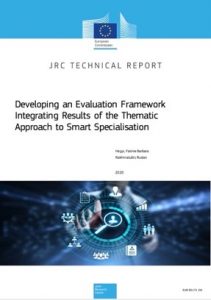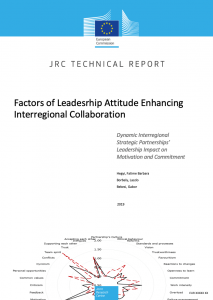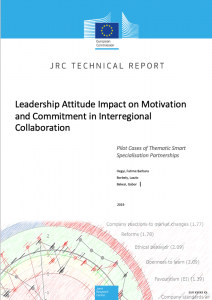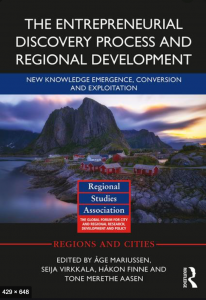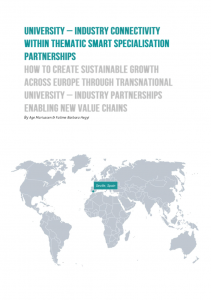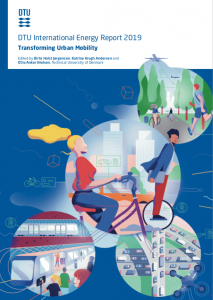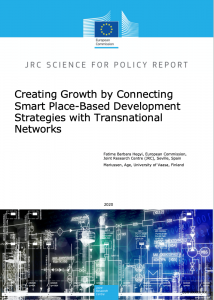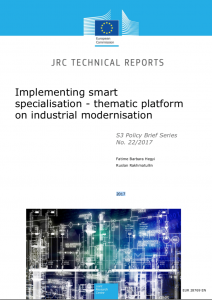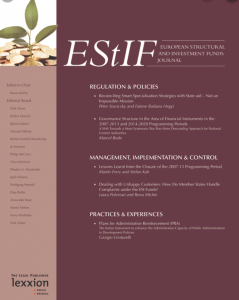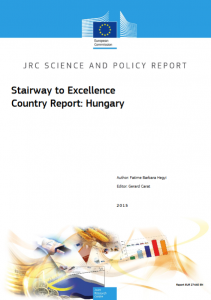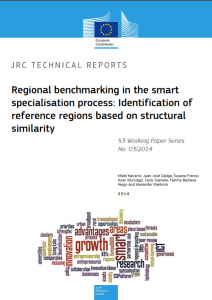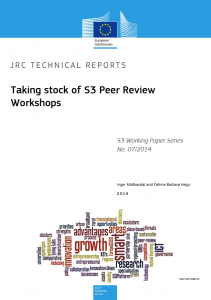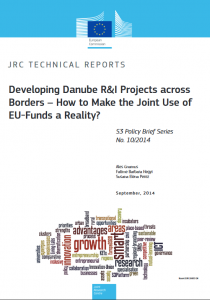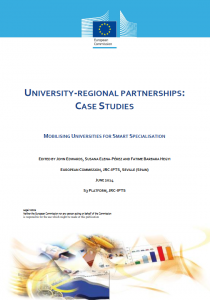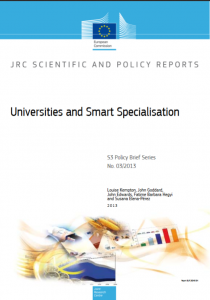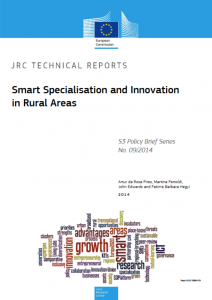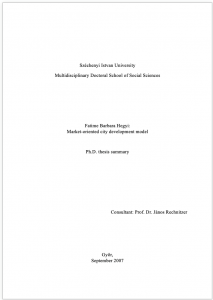Legutóbbi publikációk
- A publikációk a képekre kattintva érhetőek el -
Joint interregional initiatives can allow participating regions to mitigate risks of failure through a collective use of limited resources while identifying potential improvements or shortcomings. By working together, regions can clarify their vision and ambitions to occupy specific parts of the industry value chain.
Joint pilot activities can also help regions get a better picture as to how strong their positions are and whether specific clusters of global value chain activities in their partner regions are similar or complementary to their own activities. Furthermore, participating regions continue engaging with the industry while anticipating the likely evolution of the industry globally.
Finally, by monitoring such activities regularly, regions can assess the challenges and opportunities that can arise from future industry trajectories. By feeding this information back into their each partner’s smart specialisation strategy, regions are able to confirm the validity and relevance of previously selected RIS3 priority areas so that they could prepare themselves to respond to future challenges and opportunities in a proactive manner.
Abstract: The scale of response required for current environmental challenges requires the reinvention of established economic, social and political conventions from consumption through investments, travel, social interactions to decision making. Leadership has been recognised as an important factor in achieving growth and development at regional or local levels and effective leadership contributing to success of places. Given the nature and urgency of the problem, when addressing grand challenges related to environmental change, policies and related actions also refer to challenges of leadership in terms of capabilities, legitimacy and credibility. Therefore, it is important to analyse the context and impact of leadership at urban level in actions addressing specific agendas related to climate and environment. It is crucial since cities are often the first responders of climate emergencies, while urban decisions have tremendous impacts on climate. Likewise at city level, clear leadership in addressing environmental challenges can be identified as certain cities are on the front line of sustainable development efforts. In such cases, the impact of leadership on the motivation and commitment of stakeholders in specific actions can provide an insight into how leadership contributes to transform places as well as organizations and capabilities. Such transformations enable places to adapt to social, economic and environmental changes.
How to cite: Hegyi, Fatime Barbara, Leadership to address urban environmental challenges. Mark and Focus, vol 3 issue 1 April 2020. Pp 16.
Abstract: Interregional collaborative actions led by visibly focused and determined lead actors with a well-defined governance structure are more likely to be successful in attaining their objectives. Thus, this research proposes to examine the role of good governance and leadership contribute to the overall sustainability and viability of interregional initiatives. Accordingly, the paper explores how the leadership of the cross-border partnerships effect the motivation and commitment within the partnership by comparing attitudes of leaders and participants to explore the potential for more effective operation. The assessment framework has been developed with the aim to assist leading stakeholders of interregional collaborative actions to ensure efficiency, sustainability and success of their projects in achieving their objectives. The proposed assessment framework highlights areas of leadership where adjustments or changes are needed in order to contribute to the viability of cross-border collaborative efforts, examining the motivational and attitudinal indicators. Regularly assessing the impact of leadership on the motivation and commitment of actors across participating entities contributes to the efficiency and sustainability of collaborative actions by signalling issues of motivation and commitment. Through such assessment, specific areas can be highlighted, where there is lack of motivation and commitment towards the partnership, the leadership, the team and the work itself. Through regular re-assessments, effects of leadership practices or previous decisions can be measured.
The assessment framework has been developed in a way that it can be applied to any collaborative actions that have a well-defined governance structure with designated leadership.
How to cite: Hegyi, Fatime Barbara, and Laszlo Borbely and Gabor Bekesi, Factors of Leadership Attitude Enhancing Interregional Collaboration. Dynamic interregional strategic partnerships’ leadership impact on motivation and commitment. EUR 30151 EN, Publications Office of the European Union, Luxembourg, 2020, ISBN 978-92-76-17503-2, doi:10.2760/277185, JRC120216
Abstract: Previous research has proposed an assessment framework that allows to evaluate the impact of leadership on motivation and commitment of cross-border collaborative actions. The assessment framework has been developed with the aim to assist leading stakeholders of interregional collaborative actions to ensure efficiency, sustainability and success of their projects in achieving their objectives. The proposed assessment framework highlights areas of leadership where adjustments or changes are needed in order to contribute to the viability of cross-border collaborative efforts. Regularly assessing the impact of leadership on the motivation and commitment of actors across participating entities contributes to the efficiency and sustainability of collaborative actions by signalling issues of motivation and commitment. Through such assessment, specific areas can be highlighted, where there is lack of motivation and commitment towards the collaboration, towards the leadership, the team or the work itself. Through regular re-assessments, effects of leadership practices or previous decisions can be measured. Interregional thematic Smart Specialisation partnerships led by visibly focused and determined lead regions with a well-defined governance structure are more likely to be successful in attaining their objectives of realising joint investment projects along shared Smart Specialisation priority areas. Thus, building on the experiences of the thematic Smart Specialisation partnerships, this research proposes to examine the role of good governance and leadership contribute to the overall sustainability and viability of the partnerships. Accordingly, the paper explores how the leadership of the thematic Smart Specialisation partnerships effect the motivation and commitment within the partnership by comparing attitudes of leaders and participants to explore the potential for more effective operation. Accordingly, in this paper, the previously proposed assessment framework is been piloted on two thematic Smart Specialisation partnerships; nevertheless the framework has been developed in a way that it can be applied to any collaborative actions that have a well-defined governance structure with designated leadership.
How to cite: Hegyi, F.B., and L, Borbely and G. Bekesi, Leadership Impact on Motivation and Commitment in Interregional Collaboration. Pilot Cases of Thematic Smart Specialisation Partnerships. EUR 30152 EN, Publications Office of the European Union, Luxembourg, 2020, ISBN 978-92-76-17505-6, doi:10.2760/79420, JRC120217.
Abstract: Since 2015 the European Commission has been working hard with interregional thematic S3 partnerships supporting them to figure out how to go about teaming up and developing joint efforts in the best way. By preparing this manual, the European Commission is not only able to document the overall methodological journey taken by the thematic partnerships, but also the many good practices observed during the past few years. This manual refers to to the experience gained in the context of the thematic S3 platforms.
Once qualified, partnerships are encouraged to follow a methodology in line with a specific structure (work-flow) that takes these new partnerships through a number of steps. This work-flow follows an iterative and non-linear process which can be understood as a dynamic flow of activities that result in living documents and outcomes that require continuous monitoring and review.
How to cite: Rakhmatullin Ruslan, Hegyi Fatime Barbara, Ciampi Stancova Katerina, Gomez Javier, and Mieszkowski Krzysztof, Method-ological Manual. Developing Thematic Interregional Partnerships for Smart Specialisation. A Practical Guide to Building and Managing Interregional Smart Specialisation Partnerships. EUR 30172 EN, Luxembourg: Publications Office of the European Union, 2020. ISBN 978-92-76-17907-8, doi:10.2760/564759, JRC116630
Abstract: The first phase of smart specialisation focused on development of regional place-based strategies, including analysis of regional domains, governance, priorities and monitoring, enabling entrepreneurial discovery processes. Based on evaluations of results from this period, the next step is to grow larger, stronger and more dynamic regional and transnational innovation eco-systems. This is achieved by connecting regional partnerships to macro-regional and European knowledge networks, such as transnational thematic partnerships. This chapter documents key steps made by the European Commission, regional partners and clusters in organising these networks, through scoping, mapping, monitoring and multi-level systems of governance. The relation between these transnational networks and the experiments with pilots undertaken in 2018 is mentioned. Various cases, such as textile, agriculture, photonics and 3D printing are used as examples. The chapter presents a conceptual framework for analysing how this experiment may have impacts on transnational learning, entrepreneurial discovery processes and innovation ecosystems through the concepts of regional knowledge space, relational knowledge space and third space. A successful case of institutionalisation, co-management of a knowledge commons within photonics, is presented.
How to cite: Mariussen, Age and Fatime Barbara Hegyi and Ruslan Rakhmatullin (2019): Smart specialisation and interregional learning via thematic partnerships. In: Mariussen, Age and Seija Virkkala, Håkon Finne, Tone Merethe Aasen (2019). Entrepreneurial Discovery Process and Regional Development: new knowledge emergence, conversion and exploitation. Routledge, Abingdon. DOI: 10.4324/9781351273763-12
Abstract: The paper explores how to create sustainable growth across Europe through transnational university – industry partnerships enabling new value chains. Strategic inter-regional cooperation with strong political commitment supports the vision that transnational networks have the potential to overcome the fragmentation of European systems of innovation and to create new, globally competitive European clusters. The primary objective of the thematic approach to S3 is to develop and enhance European value chains in specific areas linked to participating regions’ S3 priorities, which is achieved through exploiting complementary research and innovation capabilities, building up necessary capacities, and overcoming interregional fragmentation, and lack of critical mass. This requires flexible governance structures and incentives that allows a constant interaction between key stakeholders, among which universities’ are key.
How to cite: Mariussen, A. and Fatime Barbara Hegyi (2019): University – Industry Connectivity within Thematic Smart Specialisation Partnerships. How to create sustainable growth across Europe through transnational university – industry partnerships enabling new value chains. University Industry Innovation Network, Amsterdam.
Abstract: Urban mobility is in transformation. Examples of drivers underpinning this ongoing transformation are need for sustainable and clean solutions, urbanization, health concerns, growth of e-commerce, new types of vehicles, digitalization, sharing economy, exploitation of big data, artificial intelligence induced disruptions, etc. Overall, the current trends place high demands regarding introduction of new and changed mobility solutions that are embracing novel technologies and adequate (public) planning and management of those. Adequate public planning includes the introduction – and regulatory implications – of new types of business models (generically often coined as “mobility as service” etc.). With new solutions, the efficiency and interplay of the transportation technologies may be improved but for a realized impact it is generally required that this be combined with behavioural change. Given the complexity of the area, a systemic approach is required including cross-disciplinary and cross-sectorial facilitation. One key component to handle the ongoing transformation is to educate, upskill and empower stakeholders including present and future professionals and citizens. This, in turn, imposes challenges for the existing educational bodies, public authorities in terms of both meeting volume and content demands. This may include adjusting education policy frameworks, educational formats, methods and scope, qualification frameworks, stakeholder engagement processes by challenging the present structure in terms of disciplines and traditions. Anticipating future educational needs based on labor market needs is about responding to structural changes in demand for labor and of competence structures with agile training solutions. Given the complexity of urban spaces, the identification of skill gaps and corresponding actions require a close and continuous alignment of needs, objectives and efforts of all key actors in the field or urban mobility: educational institutions, municipalities, transport service providers, industry, legislators and the community. The authors propose to a set of critical skills for future urban mobility taken into consideration the emergence of civic laboratories that reinventing the cities from bottom up through open data and open source platforms.
How to cite: Hegyi, Fatime Barbara, Henrik Morgan and Martin Vendel (2019): Urban mobility in transformation: demands on education to close the predicted knowledge gap. In: Holst Jørgensen, B and Katrine Krogh Andersen and Otto Anker Nielsen (eds.) DTU International Energy Report 2019. Transforming urban mobility. Technical University of Denmark, Copenhagen.
Abstract: In the past years, the European Commission launched three thematic Smart Specialisation platforms to support interregional collaborations and activities in strategic areas linked to agri-food, energy and industrial modernisation. The three thematic platforms aim to support European Union regions committed to co-invest in strategic growth areas. As of 2018, 28 interregional partnerships work under these platforms to realise joint investment projects along shared Smart Specialisation priority areas, which is a result of a multi-level governance process initiated and supported by the European Commission and inspired by early bottom up initiatives, such as Vanguard. This science for policy paper explains how thematic partnerships build on the efforts and results achieved in national and regional Research and Innovation Strategies for Smart Specialisation. Thus, the paper explains, how transnational domains are identified, how governance of transnational partnerships are organized, how scoping and mapping of competences are performed and how, as a result of this, new European innovation ecosystems are emerging. With reference to existing literature and experiences so far, the paper outlines a conceptual framework for future studies of how transnational cooperation may strengthen regional place based development strategies and improve regional innovation capabilities. Key analytical concepts are proximity, knowledge complexity, entrepreneurial discovery processes, stakeholder analysis and cluster emergence.
Abstract: This paper offers an overview of policy and economic reasons behind the launch of the new Smart Specialisation Platform for Industrial Modernisation. It is argued that modernisation of the European Industry depends upon multiple innovations across many industrial areas linked to emerging value chains. Some European regions have access to leading R&D and upstream innovation facilities; others have industrial skills needed in downstream testing and industrial upscaling. This paper looks at how the new Industrial Modernisation Platform can help European regions to create and/or join transnational networks of knowledge and expertise, and drive the development of transnational and macro-regional value chains. Cooperation and outward-looking disposition promote an understanding of the competitive position of the country/region with regard to others, and with respect to global value chains. The paper summarises the progress made since the formal launch of the new platform in June 2016 and offers an overview of the existing partnerships that are currently supported by the platform.
How to cite: Hegyi, F. B., and R. Rakhmatullin (2017). Implementing smart specialisation – thematic platform on industrial modernisation. EUR 28769 EN. doi:10.2760/312534
Abstract: This article highlights the relevance of State aid law both for policy makers and aid grantors when implementing smart specialisation strategies (S3). Smart specialisation involves member states or regions focussing their investments related to research and innovation on areas that will exploit emerging opportunities and market developments in a coherent manner, while State aid law contributes to the effective implementation of policies, controls the spending of public funds and prevents subsidy races between Member States, thereby enabling to the maintenance of effective competition on the internal market. The article aims to contribute to the cross-policy approach necessary for the efficient use of European Structural and Investment Funds. It also shows that complying with State aid law can be done with less administrative burden than in the previous programming period, however planning is needed to ensure compliance and to minimise risk of breaching the requirements. Thus, the right approach to State aid law is the early recognition of situations where State aid may be present and making the necessary steps to avoid the risk of repayment to the grantor (recovery).
How to cite: Staviczky, Peter and Fatime Barbara Hegyi (2017). Reconciling Smart specialization strategies with State aid – not an impossible mission. European Structural and Investment Funds Journal, Berlin.
Abstract: In the frame of the Stair way to Excellence project, country analysis was performed for the EU MS that joined the EU since 2004, with the objective to assess and corroborate all the qualitative and quantitative data in drawing national/regional FP7 participation patterns, understand the push–pull factors for FP7/H2020 participation and the factors affecting the capacity to absorb cohesion policy funds. This report articulates analysis on selected aspects and country-tailored policy suggestions aiming to tackle the weaknesses identified in the analysis.
How to cite: Hegyi, Fatime Barbara (2015). Stairway to Excellence. Country Report: Hungary. JRC Science and policy report. Joint Research Center, Seville. DOI: 10.2791/28100
Abstract: Regional benchmarking can be of great help in making strategic decisions within the process of the design and implementation of regional Research and Innovation Strategies for Smart Specialisation (RIS3). It can help positioning a region with respect to other regions in Europe and facilitate policy learning based on the transfer of good practices across borders. One of the most basic conditions required for drawing lessons from regional benchmarking is to compare homogeneous regions and learn from equivalents. This paper aims to provide a new methodology for the identification of homogeneous regions for regional benchmarking; identifying groups of homogeneous regions using variables that are similar in nature; focusing solely on structural conditions, thereby overcoming the flaws produced by mixing variables of a different nature (comparing structural indicators with performance and/or behavioural indicators).
How to cite: Mikel Navarro & Juan José Gibaja & Susana Franco & Asier Murciego & Carlo Gianelle & Alexander Kleibrink & Fatime Barbara Hegyi, 2014. „Regional benchmarking in the smart specialisation process: Identification of reference regions based on structural similarity,” JRC Working Papers JRC89819, Joint Research Centre, Seville.
Abstract: While advocating that the Smart Specialisation is a process in which the bottom up involvement of stakeholders is crucial, the S3 Platform has from 2012 organised a number of informal Peer Review workshops in which peers from all across Europe, experts and Commission Staff have given feedback and policy advice to regions and countries that have presented their ongoing process of designing and developing RIS3. This paper is a technical report of experiences and perceived impact from the regions and countries which were reviewed in the first twelve Peer Review Workshops during 2012 and 2013. The findings and reflections presented were produced in a survey and a stock-taking event being organised in November and December 2013 and are discussed in relation to further development of the work of the S3 Platform.
How to cite: Midtkandal, Inger and Fatime Barbara Hegyi (2014). Taking stock after two years of S3 Peer Review Workshops. JRC Technical report 07/2014. Joint Research Center, Seville.
Abstract: This Policy Brief analyses the opportunities and challenges that need to be addressed and handled with an integrated approach in order to assure a well-supported and effective transnational cooperation in the Danube macro-region. Cooperation among Danube countries has particular importance as regards to coordination of Research and Innovation (R&I) activities since they contribute significantly to competitiveness and economic growth of the macro-region and are at the same time the areas where cooperation and knowledge sharing across borders may crucially contribute to achieving best results. The purpose of this Policy Brief is to identify and examine the key issues that can contribute to the enhanced R&I cooperation in the Danube macro-region. On the other hand the report also briefly summarizes discussions among the experts at the workshop organised by DG REGIO and DG JRC in Brussels in April 2014. The report thus aims to take a stock of the state-of-the art of the current Danube cooperation activities and provide some guidance to the stakeholders on how to best enhance R&I cooperation in the Danube macro-region. The guide attempts to highlight some concrete suggestions on how to better implement governance mechanisms of transnational R&I cooperation, to revise the existing financing tools of cross-border and transnational cooperation in support of the project holders, and points out some synergies between EU funding sources that may be exploited to facilitate transnational R&I cooperation in the Danube macro-region.
How to cite: Gnamus, Ales and Fatime Barbara Hegyi and Susana Elena Perez (2014). Developing Danube R&I Projects across Borders – How to Make the Joint Use of EU-Funds a Reality? JRC Technical report. Joint Research Center, Seville.
Abstract: Once S3 are in place universities can be expected to have a key role in implementation. This may include research work but also the interpretation of ideas produced across the world through international academic networks. The role of universities also goes well beyond research and includes training of future high skilled labour, entrepreneurs and business leaders. Universities are civic institutions too and have a unique potential to increase the knowledge of a country, region or city where they are located. In brief, they are a vital part of national and regional innovation systems whether this results in more technology transfer to high tech firms or the co-production of solutions for societal challenges.
Universities have long been involved in projects outside the faculty’s walls. However, the smart specialisation agenda requires them to go beyond ‘contractual’ activities and build a long lasting strategic partnership with regional authorities. This type of ‘transformative’ relationship can be a real agent for change.
How to cite: Edwards, John and Susana Elena Perez and Fatime Barbara Hegyi, 2014. University-regional partnerships: case studies. Mobilising Universities for Smart Specialisation. Joint Research Center, Seville.
Abstract: This publication analyses the potential role of universities in the development and implementation of RIS3. Universities are often crucial institutions in regional innovation systems, especially in those with an absence of a dynamic, research led private sector, and there is rich history of academic and policy analysis in this area. However, with the new Smart Specialisation agenda, universities have a potentially pivotal role to play in its delivery. Yet there are a number of challenges and obstacles, which must be considered, in addition to the numerous opportunities. This Policy Brief makes concrete suggestions on how universities can be integrated into RIS3 to deliver their desired economic and social outcomes.
How to cite: Kempton, Louise and John Goddard and John Edwards and Fatime Barbara Hegyi and Susana Elena Perez (2014). Universities and Smart Specialisation. JRC Technical Reports, Joint Research Center, Seville. doi:10.2791/52851, ISBN 978-92-79-34717-7.
Abstract: This publication has the twin aims of showing that Research and Innovation Strategies for Smart Specialisation (S3), despite their sectoral origins, provide a favourable and supportive framework for innovation in rural areas and, on the other hand, that there is a wide range of innovation activities in rural areas, often unmentioned in the innovation policy literature, which can strongly benefit from and reinforce the impact of the new generation of European Regional Policy. The paper discusses the most significant elements of S3 related to regional development in rural areas, presenting the main challenges and opportunities for knowledge-led development with reference to both the current policy and theoretical landscapes and some relevant emerging regional experiences. In particular, we investigate how the main novelties of S3 seem able to overcome the urban bias of past innovation policies, when the rural dimension of innovation has often been neglected, affecting its contribution to economic growth and regional development related to rural resources and actors.
How to cite: Rosa Pires, Artur and Martina Pertoldi and John Edwards and Fatime Barbara Hegyi (2014). Smart Specialisation and Innovation in Rural Areas. JRC Technical reports, Joint Research Center, Seville. doi:10.2791/13227, SBN 978-92-79-43166-1
Abstract: The insights from this booklet — thanks to the valuable contributions of national and regional authorities — show that Smart Specialisation has gone far beyond the mere fulfilment of the ex-ante conditionality criteria linked to Cohesion Policy allocations. It has triggered a change in the way innovation-driven regional development policies are dealt with across Europe, confirmed by the outcome of a number of recent surveys. These “Smart Stories” will take you through the features of Smart Specialisation as it has been applied in a number of EU countries and regions, letting you further explore the concept and its policy implications, and identify com- plementarities and potential for mutual learn- ing and collaboration. The period of strategy development has in one sense finished; howev- er, the process of implementing and monitoring S3 will hopefully lead to many more “Smart Stories” to be shared across all territories of the EU.
How to cite: Edwards, John and Fatime Barbara Hegyi (eds): Smart Stories – Implementing Smart Specialisation across Europe. European Commission. EUR 27891 EN; doi:10.2791/79450
Abstract: Marketing is the tool for the competition between cities and consequently it is the source of development and power. Market-oriented city development signals a group of theories and processes that are used by profit and non-profit organizations to sell their products, services and ideas for consumers. Marketing, and strategies designed for the market of products and services are more and more entering the world of local governmental decision making, which shows that city development requires a market-oriented city planning, during which more and more functions must operate according to the opportunities and expectations of the market. As a result, local governmental activities must function within the frameworks provided by the market, which signals a shift from a supply driven to a demand driven approach in planning, performance and communication. Therefore, local governmental marketing (LGM) serves to set economic, social, cultural goals in a way that these goals are most fit to the needs of targeted consumers. With the use of marketing at the local governmental level, the development of the city is principally in line with the needs of consumers. At the same time it serves some favourable and desired economic and social processes. Beyond building on the values and assets of the city, LGM legitimates the goals and plans of the city in the eyes of the local communities in a manner that it represents private and public interests within the developments of the city. Because planning to be and to become successful it must be based on the agreed and reconciled private and public interests.
I have analysed how market processes affect the local governmental decision making, how competitiveness can be understood in relation to cities, how marketing can be used in city management, what is the product in place development, how various consumers behave, what are the specialties of the market, what type of strategies are to be used in case of a successful place development and how the product should be communicated.Based on the analysis of existing literature in the theme, I have developed a model, which I call the market-oriented city development model. The model serves to provide a framework for local governments to evaluate and assess the effectiveness of their place marketing activity. In the empirical part of the thesis, the model and its effects on competitiveness has been tested in case of 300 Hungarian cities.
How to cite: Fatime Barbara Hegyi, Marketoriented city development modell – PhD Thesis. Szechenyi Istvan University, Gyor, 2008.

